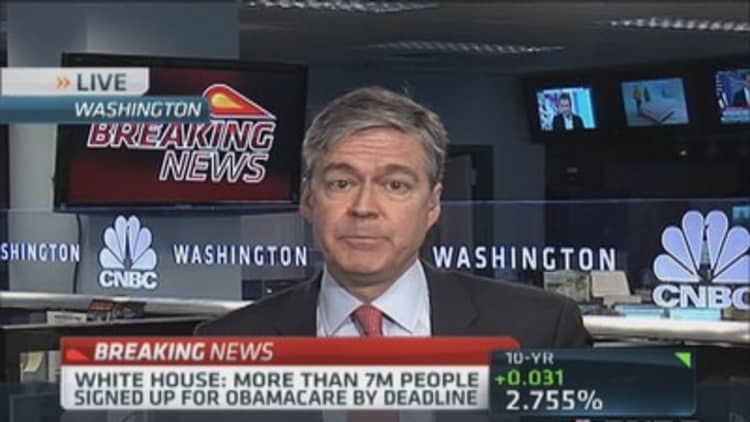Just one day after Obamacare open enrollment ended, Maryland became the first state to take drastic action to fix its flawed website. It likely won't be the last.
The board of the Maryland Health Benefit Exchange has decided to adopt the technology platform of Connecticut's smooth-running marketplace.
Maryland has spent more than $125 million building and running its own state exchange. But the site has been plagued by problems since open enrollment started. So much so, that a federal inspector general launched an investigation last month.
Exchange leaders said it would cost more than $66 million over the next year or more to fix the existing system. After considering joining the federal HealthCare.gov exchange, which has had its own problems, the board decided to leverage Connecticut's existing product.
In a written statement, Maryland Gov. Martin O'Malley and Lt. Gov. Anthony Brown called the state's website "a source of great frustration" that "did not meet expectations." They went on to say "the vendors we hired failed to build us the platform they promised."
Read MoreMaryland Obamacare site eyes eHealth deal, Oregon next?
Maryland will accept Connecticut's system as-is, with what it calls "only minor retrofitting" for branding, notices and interfaces and to accommodate Maryland's specific rules. The goal is to have the system up and running for the start of the next open enrollment period in November.
Maryland will get the code for free. But will spend between $40 million and $50 million, including costs from Connecticut's primary IT contractor, Deloitte, as well as hardware and software licensing.
States sharing infrastructure on public programs is not unprecedented. Hawaii and Arizona work together on a Medicaid management information system, as do Michigan and Illinois.
And there are similar partnerships around the country for unemployment systems.
But making this partnership work is no small task, according to Rick Howard, a research director at Gartner, an IT research and advisory company. Each state has its own business rules, workflows, insurance carriers and data architecture. Integrating all of that by Nov. 15 is "not completely outside the realm of possibility, but highly improbable," Howard said.
He sees little risk to Connecticut's exchange, from a technology and functionality standpoint. Instead the risk is in "how to evolve the platform," he said. "The client has needs, how much to charge, can they opt out if you're doing something they don't want to do. There are technology risks, but those are much lower than the business risks."
Read MoreThe Obamacare exchange tally: $36K per enrollee?
Access Health CT CEO Kevin Counihan agreed. "There's not a technical risk for us. This would not impact the service to our residents and small businesses," he said. "I suppose if there's any kind of risk it's if we're involved in an engagement that doesn't work successfully and it would be viewed as perhaps hurting the reputation of us as a state."
But he doesn't think that will happen. "We're pretty disciplined about what we take on. And I would tell you that we wouldn't take on a project that we didn't think we could be successful in. Mutually."
Connecticut's Access Health CT site has been considered a model.
Maryland Health Connection, on the other hand, crashed as soon as it launched Oct. 1, and did not come online until hours later. Two days later, visitors to the exchange were greeted with a message that "the online marketplace may be temporarily unavailable as we conduct additional maintenance and test improvements in performance."
Read MoreThe real winner website of Obamacare
After four weeks, problems persisted, with exchange leaders acknowledging "we have not been satisfied with the performance ... or with the pace of improvements to the site."

In December, Maryland Health Connection Executive Director Rebecca Pearce resigned, and in late February, the exchange fired its primary IT contractor, Noridian Healthcare Solutions.
In addition to downtime for fixes, the exchange has had issues with lost and frozen applications, incorrect subsidy determinations and feuding contractors.
Maryland enrolled 63,002 people in private health plans as of the end of open enrollment on March 31. Connecticut, a smaller state with fewer uninsured residents, enrolled 76,597 people.
Maryland likely won't be the only state to dump its own exchange, said Howard, who sees Oregon, Minnesota and Massachusetts as likely candidates to follow Maryland. He calls all four state exchanges "outright failures."
Read MoreHere are the healthiest counties in America
He also expects most states on the federal exchange to come off in the next few years, taking back some autonomy.
"States really do need to have a better understanding of their marketplaces, to have a role in plan management, plan selection," Howard said "They know their citizens, their unique needs."
And, in fact, Counihan said Connecticut has been in talks with four other states, some on the federal exchange, some running their own sites, to provide similar services.
Consolidation is the most likely course of action for everyone, Howard said. He doesn't expect any more states to start their own exchanges. Instead, they'd be more likely to join some other multistate exchange.
He pointed to Kentucky, with its successful, "clean, no-frills model" exchange and California, which has outpaced other states in enrollments, as states that could follow Connecticut's lead in franchising their services. He also expects new vendors to enter the fray.
—By CNBC's Jodi Gralnick. Follow her on Twitter @jodigralnick.

